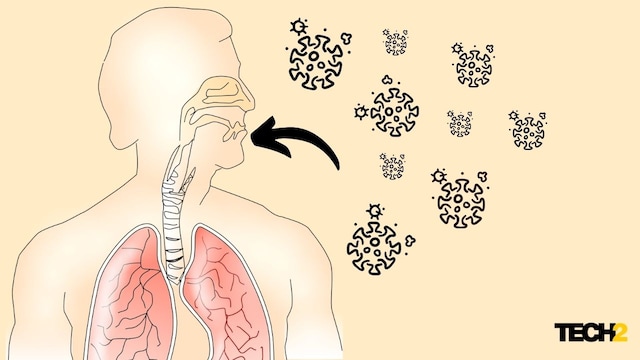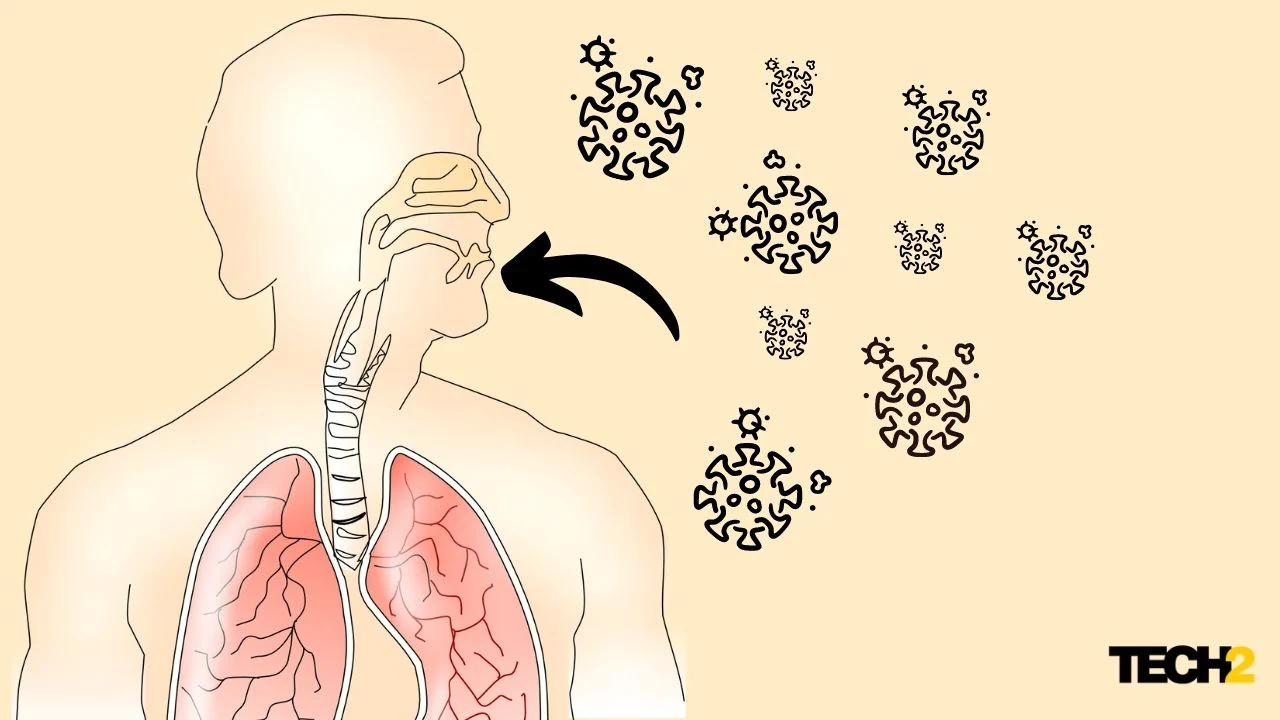Respiratory allergies might be harmless at first but if left untreated, can develop into more chronic respiratory disorders.

COVID-19 can affect organs of the body and detecting signs of the illness helps the healthcare staff to identify whether the patient is infected with the virus. Image credit: Tech2/Abigail Banerji
COVID-19 is a respiratory illness caused by the SARS-CoV-2 virus strain. It is a contagious disease that spreads from person to person mainly through the respiratory route, that is via coughing, sneezing, talking or breathing. With COVID-19
is a respiratory illness caused by the SARS-CoV-2 virus strain. It is a contagious disease that spreads from person to person mainly through the respiratory route, that is via coughing, sneezing, talking or breathing. With COVID-19 cases rapidly multiplying in the country, comparisons have been drawn to other respiratory illnesses such as the common cold, flu and seasonal allergies. While most of these have similar symptoms including fever, body aches, chills, and cough, each can be distinguished by its impact on the human body. Certain strains of the coronavirus
cases rapidly multiplying in the country, comparisons have been drawn to other respiratory illnesses such as the common cold, flu and seasonal allergies. While most of these have similar symptoms including fever, body aches, chills, and cough, each can be distinguished by its impact on the human body. Certain strains of the coronavirus are quite common and only cause mild symptoms. However, some strains are more severe and can cause complications in certain age groups. Drawing distinctions among these illnesses will help the public implement proper measures when responding to the virus.
are quite common and only cause mild symptoms. However, some strains are more severe and can cause complications in certain age groups. Drawing distinctions among these illnesses will help the public implement proper measures when responding to the virus.
How does COVID-19 affect the body differently than other respiratory illnesses?
affect the body differently than other respiratory illnesses?
COVID-19 tends to infect the body by entering healthy cells. After invading, it makes copies of itself and multiplies throughout the body, leading to the elimination of several healthy cells. In many cases, it can also lead to lung inflammation – making it tough to breathe – or even cause pneumonia, an infection of tiny air sacs inside the lungs, wherein blood exchanges oxygen and carbon dioxide.
tends to infect the body by entering healthy cells. After invading, it makes copies of itself and multiplies throughout the body, leading to the elimination of several healthy cells. In many cases, it can also lead to lung inflammation – making it tough to breathe – or even cause pneumonia, an infection of tiny air sacs inside the lungs, wherein blood exchanges oxygen and carbon dioxide.
How does COVID-19 affect the respiratory tract?
affect the respiratory tract?
Common respiratory conditions that people mistake for COVID-19 symptoms
symptoms
- Allergic rhinitis – It is a chronic respiratory disease that causes irritation and inflammation of the membranes lining the nose. Symptoms include a runny nose, sneezing, red and itchy eyes.
- Cold —A common cold is not as dire as the flu or COVID-19
 . It is a mild infection that lasts for about five to six days, with the usual symptoms of cough, runny nose, fatigue, sneezing, headache, sore throat, etc. When infected with a common cold, it is best to rest and take the prescribed medications.
. It is a mild infection that lasts for about five to six days, with the usual symptoms of cough, runny nose, fatigue, sneezing, headache, sore throat, etc. When infected with a common cold, it is best to rest and take the prescribed medications. - Flu — The flu (or influenza) is quite like COVID-19
 in terms of disease presentation. Both cause a variety of illnesses, ranging from asymptomatic to severe to deadly, and spread through droplets, contact, and fomites, so following the same preventive measures as for the coronavirus
in terms of disease presentation. Both cause a variety of illnesses, ranging from asymptomatic to severe to deadly, and spread through droplets, contact, and fomites, so following the same preventive measures as for the coronavirus (wearing masks, maintaining social distance, disinfecting materials) will help reduce chances of getting infected. The distinguishing factor between COVID-19
(wearing masks, maintaining social distance, disinfecting materials) will help reduce chances of getting infected. The distinguishing factor between COVID-19 and influenza is the speed of transmission of the virus.
and influenza is the speed of transmission of the virus.
Since most respiratory disorders have overlapping symptoms, respiratory allergies also share common symptoms with COVID-19 , resulting in misguided panic among patients. It is important that one must be sure about the source of symptoms to contain the spread of the deadly virus.
, resulting in misguided panic among patients. It is important that one must be sure about the source of symptoms to contain the spread of the deadly virus.
Are symptoms a reliable or unreliable indicator of COVID-19 ?
?
COVID-19 affects many organs of the body, hence, people infected with the virus may manifest a wide spectrum of symptoms. Detecting the signs of the illness is a reliable source and helps the patient and healthcare staff identify whether they have the coronavirus
affects many organs of the body, hence, people infected with the virus may manifest a wide spectrum of symptoms. Detecting the signs of the illness is a reliable source and helps the patient and healthcare staff identify whether they have the coronavirus infection. Accurate diagnosis ensures people take all precautionary measures to avoid transmitting the infection and receive timely and appropriate care.
infection. Accurate diagnosis ensures people take all precautionary measures to avoid transmitting the infection and receive timely and appropriate care.
Besides common symptoms COVID-19 shares with other respiratory illnesses, there are some lesser-known, unexpected symptoms
shares with other respiratory illnesses, there are some lesser-known, unexpected symptoms
- Gastrointestinal symptoms — COVID-19
 might cause nausea, vomiting, or diarrhoea, along with other common COVID-19
might cause nausea, vomiting, or diarrhoea, along with other common COVID-19 symptoms. Sometimes, gastrointestinal symptoms develop before any respiratory symptoms.
symptoms. Sometimes, gastrointestinal symptoms develop before any respiratory symptoms. - Eye infection — Pink eye, commonly known as conjunctivitis, can also be a symptom of COVID-19
 . The common eye problems linked to COVID-19
. The common eye problems linked to COVID-19 are light sensitivity and sore or itchy eyes.
are light sensitivity and sore or itchy eyes.
Awareness is key
Respiratory allergies may seem harmless at first, but when left untreated, they have the potential to develop into more chronic respiratory disorders such as asthma, sinusitis, chronic obstructive pulmonary disease (COPD), etc. In the case of persisting symptoms, patients are advised to consult a doctor at the earliest to seek appropriate treatment to prevent any long-term impacts on their health. Symptoms can be one of the many ways of identifying COVID-19 ; however, having oneself tested and consulting a doctor is a better approach to knowing the severity of one’s condition.
; however, having oneself tested and consulting a doctor is a better approach to knowing the severity of one’s condition.
The author is a pulmonology specialist, at the CK Birla Hospital, in Gurugram.










